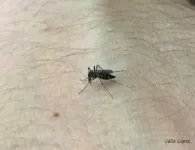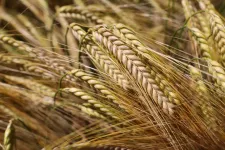(Press-News.org) The environmental impacts of removing dingoes from the landscape are visible from space, a new UNSW Sydney study shows.
The study, recently published in Landscape Ecology, pairs 32 years' worth of satellite imagery with site-based field research on both sides of the Dingo Fence in the Strzelecki Desert.
The researchers found that vegetation inside the fence - that is, areas without dingoes - had poorer long-term growth than vegetation in areas with dingoes.
"Dingoes indirectly affect vegetation by controlling numbers of kangaroos and small mammals," says Professor Mike Letnic, senior author of the study and researcher at UNSW's Centre for Ecosystem Science.
"When dingoes are removed, kangaroo numbers increase, which can lead to overgrazing. This has follow-on effects to the entire ecosystem."
The Dingo Fence, which spans across parts of Queensland, NSW and South Australia, was erected in the 1880s to keep dingoes away from livestock. At 5600 kilometres long, it's one of the longest structures in the world.
Up until now, most dingo research has been site-based or conducted using drone imagery. But NASA and United States Geological Survey's Landsat program - which has been taking continuous images of the area since 1988 - has made landscape-wide analysis possible.
"The differences in grazing pressure on each side of the fence were so pronounced they could be seen from space," says Prof. Letnic.
The satellite images were processed and analysed by Dr Adrian Fisher, a remote sensing specialist at UNSW Science and lead author of the study. He says the vegetation's response to rainfall is one of the key differences between areas with, and without, dingoes.
"Vegetation only grows after rainfall, which is sporadic in the desert," says Dr Fisher.
"While rainfall caused vegetation to grow on both sides of the fence, we found that vegetation in areas without dingoes didn't grow as much - or cover as much land - as areas outside the fence."
A domino effect
Apex predators play an important role in maintaining the biodiversity of an ecosystem.
Removing them from an area can trigger a domino effect for the rest of the ecosystem - a process called trophic cascade.
For example, an increase in kangaroo populations can lead to overgrazing, which in turn reduces vegetation and damages the quality of the soil. Less vegetation can hinder the survival of smaller animals, like the critically endangered Plains Wanderer.
Changes to vegetation triggered by the removal of dingoes have also been shown to reshape the desert landscape by altering wind flow and sand movement.
"The removal of apex predators can have far-reaching effects on ecosystems that manifest across very large areas," says Prof. Letnic. "These effects have often gone unnoticed because large predators were removed from many places a long time ago.
"The Australian dingo fence - which is a sharp divide between dingo and non-dingo areas - is a rare opportunity to observe the indirect role of an apex predator."
A harsh, dry landscape
Satellite imagery traditionally only looks at photosynthesizing vegetation - that is, plants, trees and grass that are visibly green.
But the researchers used a model to factor in non-green vegetation, like shrubs, dry grasses, twigs, branches and leaf litter.
"Non-photosynthesizing vegetation has a different reflectance spectrum to photosynthesizing vegetation," says Dr Fisher.
"By using the satellite image and a calibrated scientific model, we were able to estimate the non-green vegetation cover - which is especially important when studying a desert landscape." The model was developed by the Joint Remote Sensing Research Program, a collaborative group that includes UNSW.
While there are other contributing factors to the difference in vegetation - for example, differing rainfall patterns and land use - the satellite imagery and site analysis showed dingoes played a central role.
"There were clear differences in landscape on either side of the dingo fence," says Dr Fisher. "Dingoes may not be the whole explanation, but they are a key part of it."
Harnessing satellite intelligence
Satellite image technology is a powerful tool for assessing large-scale role of not only dingoes, but all kinds of environmental change.
In 2019, researchers from UNSW Engineering used powerful satellite radar imaging technology to map severe floods in near real-time - intelligence that could help emergency services make tactical decisions during extreme weather events.
Dr Fisher hopes to next use Landsat imagery - which is freely available to download - to study how different amounts of vegetation can influence bushfire frequency.
"Our study is an example of how satellite technology can be used in big picture environmental research," says Dr Fisher.
"With over three decades' worth of data, this technology has opened up so many research possibilities."
INFORMATION:
Since astronomers captured the bright explosion of a star on February 24, 1987, researchers have been searching for the squashed stellar core that should have been left behind. A group of astronomers using data from NASA space missions and ground-based telescopes may have finally found it.
As the first supernova visible with the naked eye in about 400 years, Supernova 1987A (or SN 1987A for short) sparked great excitement among scientists and soon became one of the most studied objects in the sky. The supernova is located in the Large Magellanic Cloud, a small companion galaxy to our own Milky Way, only about 170,000 light-years from Earth.
While astronomers watched debris ...
Unlike the Higgs boson, discovered at CERN's Large Hadron Collider in 2012 after a 40-year quest, the new particle proposed by these researchers is so heavy that it could not be produced directly even in this collider
The University of Granada is among the participants in this major scientific advancement in Theoretical Physics, which could help unravel the mysteries of dark matter
Scientists from the University of Granada (UGR) and the Johannes Gutenberg University Mainz (Germany) have recently published a study in which they endeavour to extend the Standard Model of particle physics (the equivalent of 'the periodic table' for particle physics) and answer some of the questions that this model is unable to answer. Such puzzles include: What ...
This study, published recently in the international journal Insects, was conducted by researchers from the University of Granada, the Doñana Biological Station, and the Biomedical Research Networking Centre for Epidemiology and Public Health (CIBERESP)
Researchers from the University of Granada (UGR), the Doñana Biological Station (EBD-CSIC), and the Biomedical Research Networking Centre for Epidemiology and Public Health (CIBERESP) have carried out the most comprehensive study to date of the eating patterns of the tiger mosquito (Aedes albopictus) and other invasive species of the same genus in Europe. The results of the study were recently published in the international journal Insects.
This research, which reviews ...
With a survival rate of only five years, the most common and aggressive form of primary brain tumor, glioblastoma multiforme, is notoriously hard to treat using current regimens that rely on surgery, radiation, chemotherapy and their combinations.
"Two of the major challenges in the treatment of gliomas include poor transport of chemotherapeutics across the blood brain barrier and undesired side effects of these therapeutics on healthy tissues," said Sheereen Majd, assistant professor of biomedical engineering at the University of Houston. "To get enough medicine across the blood brain barrier, a high dosage ...
Insomnia -- trouble falling asleep, staying asleep or waking up too early -- is a common condition in older adults. Sleeplessness can be exacerbated by osteoarthritis, the most common form of arthritis causing joint pain. While there are effective therapies for treating insomnia in older adults, many people cannot get the treatment they need because they live in areas with limited access to health care, either in person or over the internet.
With telephones nearly universal among the elderly, however, researchers at the University of Washington and Kaiser Permanente Washington Health Research Institute sought to determine if therapy using only a phone connection ...
CORVALLIS, Ore. - Flavor differences in whiskey can be discerned based solely on the environment in which the barley used to make the whiskey is grown, a new study co-authored by an Oregon State University researcher found.
This is first scientific study that found the environmental conditions, or terroir, of where the barley is grown impacts the flavor of whiskey, said Dustin Herb, an author of the study and a courtesy faculty member in the Department of Crop and Soil Science at Oregon State University.
"Terroir is increasingly being used to differentiate and market agricultural products, most commonly wine, as consumers grow more interested in the origins of their food," Herb said. "Understanding terroir ...
Slight differences in clinical features can help physicians distinguish between two rare but similar forms of autoimmune brain inflammation in children, a new study by UT Southwestern scientists suggests. The findings, published online in Pediatric Neurology, could provide patients and their families with a better prognosis and the potential to target treatments specific to each condition in the future.
About half of all cases of encephalitis - a rare type of brain inflammation that affects about 1 of every 200,000 people in the U.S. each year - can be traced to an infection. For a portion of other cases in which the cause isn't initially clear, researchers have discovered a link with the patients' ...
LEXINGTON, Ky. (Feb. 19, 2021) - After conducting a study to assess the need for cancer education materials in Appalachian Kentucky, members of the University of Kentucky Markey Cancer Center's Appalachian Career Training in Oncology (ACTION) program worked with faculty from the UK College of Education to create a three-part cancer education curriculum for middle and high school teachers in the region.
Kentucky is home to the highest rates of cancer incidence and mortality in the country, and that problem is further concentrated in the Appalachian region of the state. Funded by a grant from the National Cancer Institute, ACTION is a two-year program designed to prepare undergraduate and high school students for cancer-focused careers and is open to students who hail ...
WEST LAFAYETTE, Ind. -- Autonomous underwater vehicles have become versatile tools for exploring the seas. But they can be disruptive to the environment or have trouble traveling through confined spaces.
Purdue University researchers are studying an alternative: highly maneuverable, low-cost underwater gliders that operate silently. Components and sensors of the glider also can be easily swapped out or added according to a wide range of mission specifications.
"Our goal is persistent operation of mobile robots in challenging environments," said Nina Mahmoudian, associate professor of mechanical engineering. "Most underwater robots ...
BOSTON -- Numerous psychiatric studies have documented increased rates of depression and anxiety among those forced to relocate, with sudden moves often affecting individuals' social support and sense of identity and control. As the COVID-19 pandemic spread through the U.S. in March of 2020, universities evacuated students from their campuses, and thousands quickly relocated. Few studies have examined the mental health impact of the sudden disruption. In a new study of 791 undergraduate and graduate students, surveyed between April 9 and August 4, 2020, researchers from Brigham and Women's Hospital, Boston University's School of Social Work, and McLean Hospital revealed that students forced to relocate during the spring were more likely to report COVID-19-related ...




